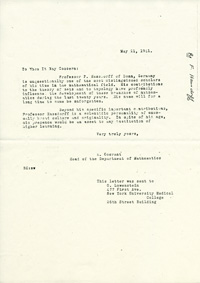
- Letter of reference for Felix Hausdorff from Richard Courant, 21 May 1941 (New York University Archive). Due to his age Hausdorff, one of the most renowned mathematicians in Germany, failed in his attempts to emigrate after the “Reichskristallnacht” of 1938. Courant and others tried to help, but without success. No university in the USA was willing to offer him a position or fellowship. He remained in Nazi Germany, losing all hope of leaving the country.
11 Dismissals and Exile
Dismissals from schools and universities began in April 1933, when political opponents and all those who were “non-Aryan” according to the Nazi definition were dismissed from positions at public institutions. At the universities, this law affected not only professors and other lecturers, but also assistants, secretaries and laboratory assistants. The Nuremberg Laws, introduced in autumn 1935, further aggravated the situation. Dismissals from all kinds of positions continued, and robbery of assets, disguised under the term “Aryanization”, accelerated. Very few German academics resisted the dismissal of their colleagues.
Most of the dismissed mathematicians attempted to begin a new life in exile. Some managed to build a new career abroad, others were less successful. Richard Courant, dismissed from the University of Göttingen in 1933, decided to leave the country that same year. In New York, he was given the task of organizing the mathematical department of the New York University Graduate School of Arts and Science. In 1946 it was renamed Institute for Mathematics and Mechanics, becoming one of the world’s leading centers for applied mathematics and mathematical analysis. In 1964 it was once again renamed Courant Institute for Mathematical Sciences. Together with another émigré, Hermann Weyl, and the American mathematician Oswald Veblen, Courant became one of the main organizers of the effort to help persecuted German mathematicians who wanted to emigrate to the USA.
Most German-Jewish mathematicians whose story is told in this exhibition were able save their lives. Others were murdered by the Nazis or committed suicide. This exhibition is dedicated to their memory.